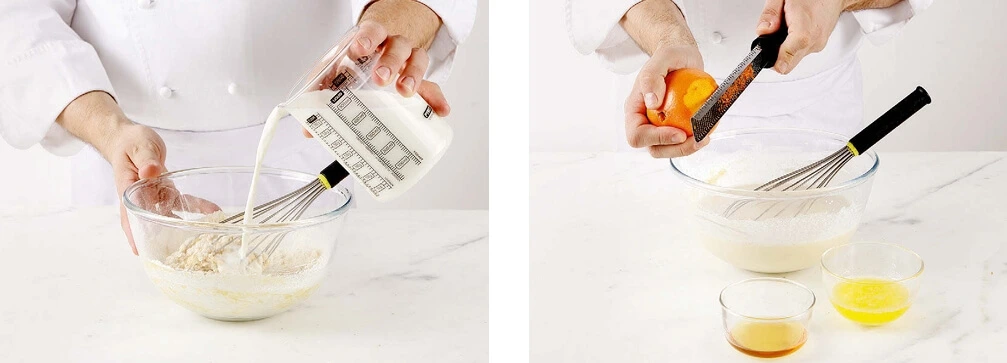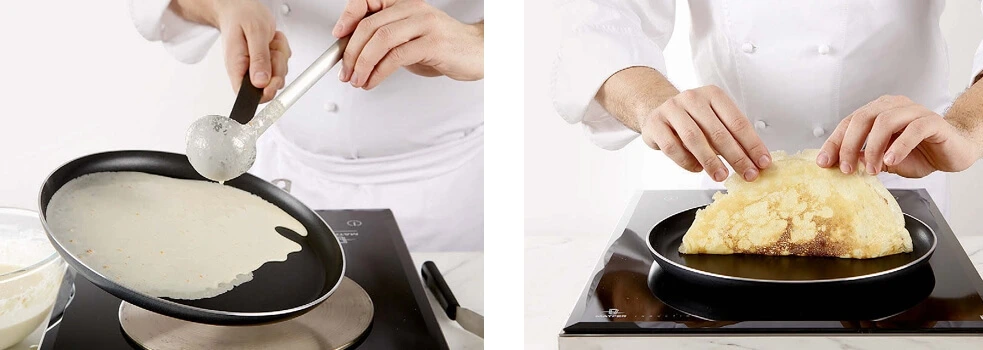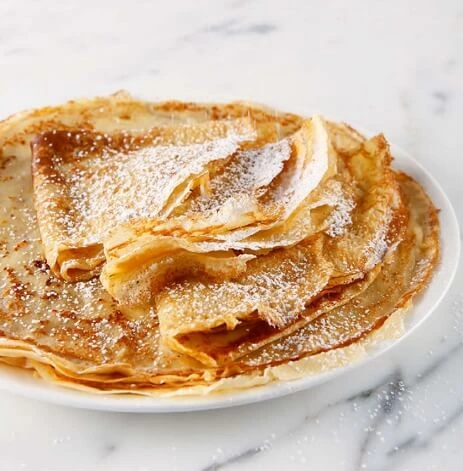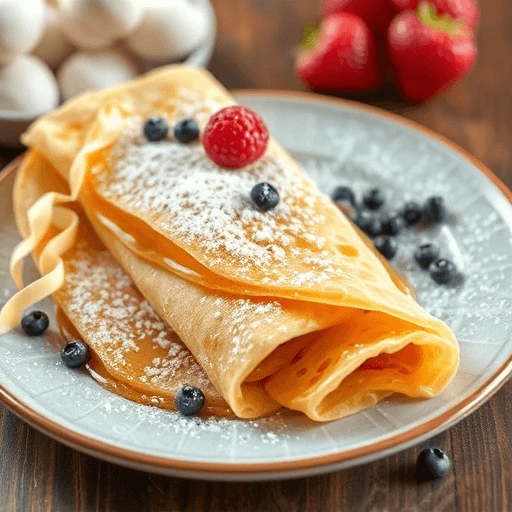Crêpes are a timeless French delicacy that embodies simplicity and elegance in every bite. Originating from Brittany in northwest France, they have become a global favorite, appreciated for their versatility and deliciousness. Thin, golden, and perfectly delicate, crêpes can be enjoyed in countless ways, from sweet to savory, and from breakfast to dinner.
The key to a perfect crêpe lies in its batter, which should be smooth, light, and slightly runny, allowing it to spread evenly across the pan, creating a uniform texture. The cooking technique is just as important: crêpes should be cooked on a moderately hot surface, giving them just enough time to form a soft, lacy edge without overcooking the center. The result is a delicate pancake, thin enough to roll, fold, or stack, and full of possibilities for fillings and toppings.
When it comes to sweet crêpes, they are often paired with classic fillings such as lemon and sugar, Nutella, or fruit preserves. For a more indulgent treat, whipped cream, melted chocolate, or a dusting of powdered sugar adds a rich finish. For savory crêpes, think about fillings like ham and cheese, spinach and mushroom, or even smoked salmon and crème fraîche. The beauty of crêpes is that they can be adapted to suit any flavor profile, making them a perfect dish for any occasion.
Whether prepared for a casual breakfast, a luxurious brunch, or a charming dinner party, crêpes offer endless opportunities for creativity. Their thin texture and slightly crispy edges provide the ideal balance to any filling, ensuring that each bite is a harmonious combination of flavors.
In France, crêpes are often enjoyed during the celebration of La Chandeleur, also known as Crêpe Day, where the tradition is to flip the crêpe with a flourish while holding a coin in the other hand for good luck. This playful and festive aspect of crêpe-making adds a charming touch to the experience.
Overall, crêpes are more than just a dish; they are a part of French culinary tradition, bringing people together to enjoy food that is simple yet refined. Whether served with a cup of coffee in the morning or as a satisfying dessert in the evening, crêpes remain a beloved treat that continues to delight people around the world.
For 10 crêpes
Preparation Time: 45 minutes
Resting Time: 2 hours
Cooking Time: 3 minutes per crêpe
Storage: Best enjoyed immediately
Equipment Needed:
- Whisk
- Sieve
- Microplane Grater
- Crêpe Pan
- Ladle
Ingredients:
- 100 g eggs
- 30 g granulated sugar
- 170 g T45 flour
- 500 g whole milk
- Zest of 1 orange
- 50 g butter
- 30 g alcohol of your choice (such as rum or Grand Marnier)
- 30 g oil
Instructions:
- Prepare the Batter: In a large bowl, whisk the eggs and sugar together until well combined. Gradually add the flour, sifting it in to ensure a smooth mixture. Slowly pour in the milk while whisking continuously to prevent lumps. Add the zest of the orange for a fresh citrus note. Finally, incorporate the alcohol and oil into the batter, giving it a silky, slightly runny consistency.
- Rest the Batter: Cover the bowl with a clean cloth or plastic wrap and let the batter rest for 2 hours at room temperature. This resting time allows the flour to absorb the liquids fully, resulting in a smooth and elastic batter that yields perfect crêpes.

- Cook the Crêpes: Heat a crêpe pan over medium-high heat. Lightly grease the pan with butter or oil. Pour a ladle of batter into the hot pan, swirling it to coat the bottom evenly. Cook each crêpe for about 1-2 minutes on one side, or until the edges lift and turn golden. Flip the crêpe and cook for another minute or so, until golden brown on both sides.

- Serve Immediately: Serve your crêpes right away while they’re still warm. You can enjoy them plain, or fill them with sweet or savory ingredients of your choice.

Chef’s Tips and Tricks:
- Prepare the Batter the Day Before: For the best results, it’s ideal to prepare the crêpe batter the night before. This allows the ingredients to fully meld together, enhancing the flavor and achieving a smoother consistency. Additionally, the rest period ensures the batter becomes thicker and easier to work with, leading to more delicate crêpes when cooked.
- “Culotter” the Pan: This French technique, known as culotter, involves heating a thin layer of oil (about half a centimeter) in the pan before you start cooking. Once the oil is hot, carefully remove it and wipe the pan with a paper towel. This technique helps to create a perfect, golden-brown color on your crêpes without drying them out. The result is a beautifully crisp edge with a soft, tender center, ensuring your crêpes cook evenly and don’t stick to the pan.
Conclusion:
Crêpes are much more than just a simple French dish; they embody the art of comfort food, blending tradition with endless possibilities for innovation. The batter itself is a blank canvas, where the delicate balance of eggs, flour, and milk creates the perfect texture—light, smooth, and airy—yet strong enough to hold a variety of fillings, both sweet and savory. With just a few basic ingredients, you can create something elegant enough for a special occasion or casual enough for a Sunday brunch.
The addition of orange zest and alcohol in the batter elevates this classic recipe, giving the crêpes an extra layer of flavor that transports the dish beyond ordinary pancakes. These subtle hints of citrus and richness are part of what makes crêpes such a versatile treat. Whether you are indulging in a sweet filling like Nutella and strawberries or savoring a savory combination like ham, cheese, and a drizzle of béchamel, the crêpe serves as the perfect vessel for whatever culinary direction you choose.
Cooking crêpes may seem intimidating at first, especially when it comes to achieving that golden, lacy edge and perfectly soft center, but with practice and patience, anyone can master this dish. The key lies in a smooth batter, proper heat management, and the right technique when flipping the crêpes. It’s a technique that, once mastered, offers infinite variations to explore, making it a rewarding recipe for anyone who enjoys cooking or hosting.
In France, crêpes are often associated with celebrations like La Chandeleur (Crêpe Day), where the tradition of flipping crêpes symbolizes good fortune for the year ahead. In addition to their symbolic nature, crêpes have a joyful, fun aspect to them, whether you’re tossing them in the pan or experimenting with new fillings and toppings. As a shared dish, crêpes bring people together, creating moments of enjoyment around the table. Whether served at a family breakfast, a festive gathering, or as a simple dessert, they never fail to charm.
So, the next time you make crêpes, remember that you’re not just cooking a meal—you’re embracing a piece of French culinary heritage, one delicious crêpe at a time. Enjoy the process, experiment with fillings, and most of all, savor the result. There’s truly nothing like a freshly made crêpe to bring joy to your day.
Question and Answer Section:
Q: Why is resting the batter so important when making crêpes?
A: Resting the batter is essential because it allows the flour to fully absorb the liquids, which helps to avoid a grainy texture in the crêpes. The resting time also gives the gluten in the flour a chance to relax, resulting in crêpes that are tender and less likely to tear during cooking. Additionally, it allows any air bubbles to settle, leading to a smoother, more even batter. This step ensures that your crêpes will have a delicate, thin texture that’s perfect for folding or filling.
Q: Can I use different types of flour in my crêpe batter?
A: Yes, you can use different types of flour, but it’s important to note that the texture and consistency of your crêpes may change depending on the flour you use. For example, T45 flour (a soft, finely milled flour) is commonly used for crêpes because it creates a soft, tender texture. However, you can experiment with other flours, such as whole wheat or buckwheat (for savory crêpes), but these will give a different flavor and texture. Just keep in mind that substitutions might require small adjustments to the liquid content of the batter to achieve the right consistency.
Q: How can I ensure my crêpes don’t stick to the pan?
A: The key to preventing crêpes from sticking is to use a non-stick crêpe pan or skillet, and to lightly grease the pan with butter or oil. It’s important to only grease the pan once before you start cooking, and not in between crêpes. If you add too much oil or butter, the crêpes may become greasy. The pan should be at the right temperature—hot enough that the batter sizzles gently when poured in, but not so hot that it burns the crêpes.
Q: Can I make the crêpe batter ahead of time?
A: Absolutely! You can make the batter the night before and refrigerate it overnight. This actually allows the flavors to develop more fully, and the batter will have an even smoother consistency the next day. Just give it a good stir before using it the next morning. If the batter thickens too much during refrigeration, you can add a small amount of milk to thin it out to the desired consistency.
Q: What are some creative ways to fill or top my crêpes?
A: The possibilities are endless when it comes to crêpe fillings and toppings! For sweet crêpes, classic options include Nutella, fresh fruit (like strawberries or bananas), whipped cream, or a simple dusting of powdered sugar. For savory crêpes, try fillings like ham and cheese, smoked salmon and crème fraîche, or even a savory spinach and ricotta mixture. You can also drizzle crêpes with sauces like chocolate, caramel, or lemon juice for an added burst of flavor. The beauty of crêpes is their versatility—they can be made to suit any flavor preference!

